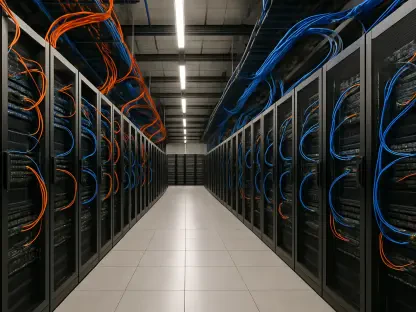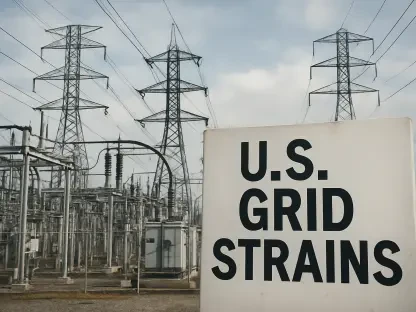Artificial intelligence (AI) is revolutionizing the energy sector, driving significant advancements in renewable energy and utility infrastructure. However, this technological leap comes with a paradox: while AI aids the clean energy transition, it also imposes substantial demands on power grids. This dual impact presents both opportunities and challenges that require strategic planning and regulatory oversight. The integration of AI into energy management systems enhances efficiency and supports the push toward renewable energy, but its ever-increasing energy consumption is a growing concern for the stability and capacity of existing power grids.
AI’s Role in Enhancing Energy Efficiency and Renewable Energy
AI is becoming an indispensable tool in ensuring the reliability and efficiency of energy infrastructure. Companies like AiDash are leveraging AI to remotely monitor utility infrastructure, addressing risks such as vegetation management that cost utilities billions of dollars annually. These AI-driven advancements contribute to the clean energy transition by enabling more effective maintenance and operation of utility assets, which is crucial in mitigating climate change. By optimizing maintenance schedules and predicting potential failures, AI helps energy providers improve system reliability and reduce operational costs.
Furthermore, AI’s ability to handle massive datasets and produce sophisticated analytical outputs accelerates renewable energy research. This capability facilitates the implementation of clean energy projects, making it possible to optimize energy production and distribution. AI’s role in enhancing energy efficiency and supporting renewable energy initiatives is a testament to its transformative potential in the energy sector. Additionally, AI technologies help in forecasting energy demand and supply, ensuring that renewable sources are used most efficiently and effectively integrated into the grid.
The use of AI in energy efficiency goes beyond operational improvements. AI-driven energy management systems can proactively control energy usage in real-time, adjusting consumption patterns based on demand forecasts and energy availability. This dynamic approach reduces wastage, lowers costs, and supports the transition to a more sustainable energy system. Moreover, AI aids in the development of energy storage solutions by optimizing battery performance and extending their lifespan, further supporting the integration of renewable energy into the grid.
The Burden of AI on Power Grids
Despite its benefits, AI technology poses significant challenges, particularly related to energy consumption. According to a report by Bain & Company, AI-driven data centers could contribute to 44% of the United States’ electricity load growth from 2023 to 2028. This surge in electricity consumption necessitates a 26% annual increase in power generation by 2028 to meet the demand. The energy consumed by AI data centers is substantial due to their need for continuous operation and cooling, which often results in a significant carbon footprint.
This rapid growth in AI-driven electricity demand highlights a paradox: while AI aids the development and integration of renewable energy, it concurrently drives substantial energy demand. This increased demand threatens to overwhelm existing power grids, presenting a significant challenge for the energy sector. Addressing this issue requires a balanced approach to energy management and infrastructure development. Moreover, the expansion of AI data centers often leads to localized energy supply constraints, exacerbating grid stability issues in specific regions.
In addition to the direct energy consumption of AI data centers, the development and deployment of AI algorithms also require significant computational power. Training AI models, particularly those involving deep learning and large datasets, demands extensive use of high-performance computing resources. These computational requirements add to the overall energy burden, making it essential to explore more energy-efficient algorithms and hardware solutions. The energy consumed in training AI models is a growing concern, and it necessitates a reevaluation of current practices to make AI development more sustainable.
Regulatory and Policy Challenges
The surge in electricity demand due to AI raises complex regulatory and policy questions. The Federal Energy Regulatory Commission’s (FERC) recent rejection of an interconnection service agreement to power a data center with energy from an existing nuclear plant illustrates the regulatory challenges presented by AI’s energy demands. The co-location of data centers with power plants could lead to increased costs for ratepayers and present resource adequacy challenges. Policymakers must consider the broader implications of AI-induced energy demand on grid stability and customer pricing.
This regulatory conundrum underscores the need for high-level leadership and strategic planning to balance AI adoption with grid reliability and decarbonization goals. Policymakers must navigate these complexities to ensure that the benefits of AI in the energy sector are realized without compromising grid stability and affordability for consumers. Furthermore, regulatory frameworks need to accommodate the rapid pace of AI advancements, ensuring that policies remain relevant and effective in addressing new challenges as they arise.
Regulatory bodies must also collaborate with industry stakeholders to develop standards and best practices for AI deployment in the energy sector. This includes setting efficiency benchmarks, incentivizing the use of renewable energy for powering AI data centers, and promoting research into sustainable AI technologies. By fostering a collaborative approach, regulators can help mitigate the potential negative impacts of AI on power grids while maximizing its benefits for clean energy initiatives. Strategic policies and regulations will be crucial in guiding the responsible and sustainable growth of AI within the energy landscape.
Advances in AI Technology and Applications
Recent advancements in generative AI have facilitated significant innovations in the energy sector. AiDash, for example, leverages these breakthroughs to perform tasks previously deemed impossible, such as large-scale remote monitoring of utility assets. This capability allows for more efficient and effective management of energy infrastructure, contributing to the clean energy transition. AI’s ability to process and analyze vast amounts of data in real time enables utilities to detect and address issues promptly, reducing downtime and enhancing overall system performance.
Similarly, companies like Paces have revived projects like their permitting insights tool, now rendered feasible and scalable by AI advances. This tool empowers clean energy developers to accelerate their projects, focusing their efforts more on community engagement and relationship building while administrative tasks are handled by AI. By automating complex permitting processes, AI helps streamline project timelines and reduce costs, making it easier to bring new renewable energy projects online. These innovations highlight the transformative potential of AI in driving the clean energy transition.
Moreover, AI is being used to optimize energy trading and market operations. Advanced AI algorithms can predict market trends, assess risk, and make real-time trading decisions, ensuring that energy is bought and sold at the most favorable prices. This not only enhances the profitability of energy companies but also contributes to a more balanced and efficient energy market. The use of AI in energy trading exemplifies how technology can be harnessed to improve both operational efficiency and financial performance in the energy sector.
AI in Nuclear Fusion Research
AI also plays a pivotal role in the ongoing research and commercialization of nuclear fusion energy. The Clean Air Task Force highlights the integration of AI in optimizing the stability and performance of fusion reactors. For example, AI tools such as DisruptionPy from MIT streamline the data retrieval and analysis processes critical to understanding and predicting disruptions in plasma stability. By analyzing vast amounts of data from fusion experiments, AI helps researchers identify patterns and optimize reactor conditions, accelerating progress toward viable fusion energy.
This AI-enabled optimization reduces the need for physical testing, offering significant time and cost savings. By pushing the boundaries of fusion technology development, AI is helping to bring the promise of nuclear fusion energy closer to reality. This potential breakthrough could provide a nearly limitless source of clean energy, further underscoring the importance of AI in the energy sector. The role of AI in fusion research highlights its ability to tackle some of the most complex and challenging problems in energy science, driving innovation and progress.
Moreover, AI is being utilized to improve the safety and reliability of fusion reactors. Predictive maintenance algorithms can monitor reactor components and anticipate potential failures, ensuring timely interventions and minimizing the risk of unplanned outages. This proactive approach to reactor maintenance enhances the overall safety and reliability of fusion power plants, paving the way for their commercial deployment. The successful integration of AI in nuclear fusion research demonstrates the technology’s potential to revolutionize not just current energy systems, but also future energy sources.
Balancing AI Adoption with Energy Management
Artificial intelligence (AI) is transforming the energy sector, driving important advancements in renewable energy and utility infrastructure. However, this technological progress brings a paradox: while AI facilitates the transition to clean energy, it also puts substantial demands on power grids. AI’s integration into energy management systems boosts efficiency and supports the shift towards renewable energy sources, helping to optimize the use of wind, solar, and other sustainable power solutions. This often results in a more reliable and cost-effective energy supply.
On the flip side, the ever-growing energy consumption of AI itself is becoming a growing concern for the stability and capacity of current power grids. This increased demand for electricity to power AI systems can strain existing infrastructure, which may not be equipped to handle the added load. Thus, the dual impact of AI in the energy sector poses both opportunities and challenges.
Strategic planning and regulatory oversight are crucial to balance these effects. Developing advanced, resilient, and scalable energy grids will be necessary to accommodate the surge in demand driven by AI while maintaining a commitment to sustainability. Therefore, policymakers, energy providers, and technology developers must collaborate to ensure AI’s benefits in the renewable energy sector are maximized without compromising the integrity of power grids.









